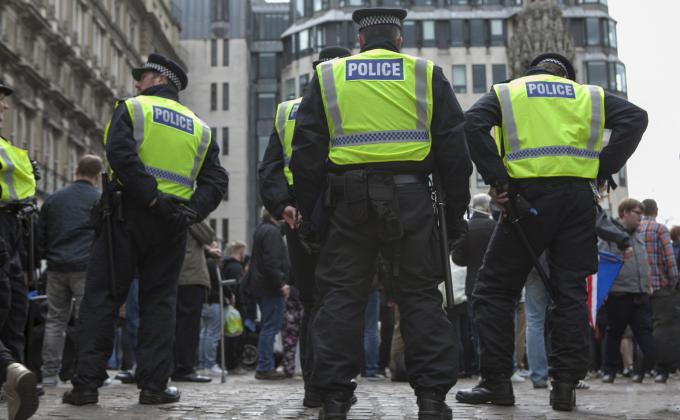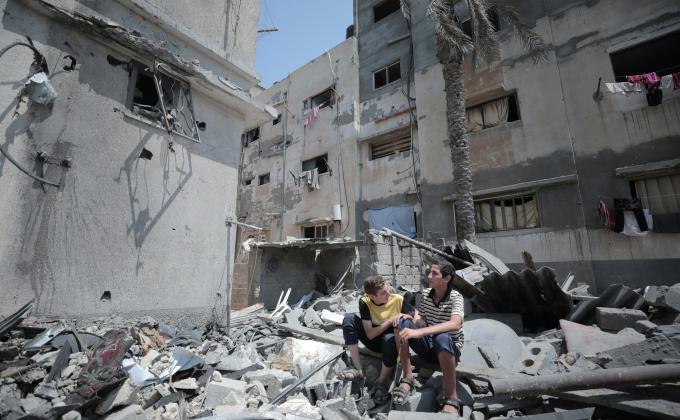On Wednesday 24 September 2014, the UN Security Council (SC) in a special session with heads of states unanimously adopted Resolution 2178 on foreign terrorist fighters, tabled by the United States (US). It was timely since this coincided with the US holding the SC presidency in September, the annual meeting of the General Assembly, and the announcement of the United States just days before that in addition to the military air strikes against the Islamic State (IS) in Iraq, it would also commence military operations in Syria. At the same time, many states are struggling with the issue of foreign fighters travelling to Syria and Iraq. In Europe especially states have been dealing with the problem over the last 24 months, and this problem is still increasing especially with the proclamation of the caliphate by IS.
Many states – in cooperation with each other or on their own account– have started to implement various measures to stop this ever-growing problem. Measures adopted vary from blocking the validity of travel documents, revoking citizenship, blocking financial assets, to prosecution of recruitment, incitement and the planning of terrorist attacks. Also intelligence services of befriended nations have stepped up their cooperation by sharing relevant information concerning the whereabouts of young people travelling to and from Syria and Iraq. Even so, and irrespective of all these measures, governments have not succeeded in stemming the exodus of foreign fighters. The key to success will to a great extent lie in successful prevention strategies that focus on inclusion and social cohesion. The question is, however, whether resolution 2178 will contribute to the development of such strategies.
This resolution attempts to present a holistic approach to the problem of foreign terrorist fighters by recognizing that terrorism will not be defeated by military force, law enforcement measures, and intelligence operations alone. It stresses that there is also a need to address the conditions conducive to the spread of terrorism, as outlined in Pillar I of the United Nations Global Counter-Terrorism Strategy. With regard to the prevention side of the approach, the SC calls upon Member States to develop and implement rehabilitation and reintegration strategies (par. 4), and encourages states to engage with relevant local communities and non-governmental actors in developing strategies to counter the violent extremist narrative that can incite terrorist acts, address the conditions conducive to the spread of violent extremism, which can be conducive to terrorism, and include relevant stakeholders in this process to adopt tailored approaches to countering recruitment and promote social inclusion and cohesion (par. 16). Except for these few paragraphs, the SC does not elaborate further on the avenues to follow, the strategies to implement to achieve these goals, or the programs that have already been developed in this respect and which could serve as an example. The instructions to states when it comes to implementing better law enforcement tools, freezing sanctions of financial assets, border management mechanisms, or intelligence sharing needs are, on the other hand, are far more specific and detailed. This unfortunately results in a rather unbalanced strategy and constitutes a missed opportunity to further the development and implementation of more genuine preventive measures.
Although the adoption of this resolution was welcomed in many circles as being very timely, the resolution also triggered an uproar of criticism and concern with regard to the far reaching powers used by the SC, its lack of clarity in the wording of the resolution, and its wide scope of applicability. Former UN Special Rapporteur on human rights and counter-terrorism, Martin Scheinin, wondered whether we were back in the state of post 9/11-panic. And he argued that the adoption of this resolution was "a huge backlash in the UN counter-terrorism regime", which "wipes out the piecemeal progress made over thirtheen long years in introducing protections of human rights and the rule of law into the highly problematic manner in which the Security Council exercises its supranational powers".
Like SC Resolution 1373, which was (also) unanimously adopted days after the 9/11 attacks, this resolution has a legislative character, meaning that it orders states in a binding clause to legislate (as far as they have not already done so) as serious criminal offences the travel or attempt to travel of their nationals and other individuals from their territories to states (other than the states of their residence or nationality) for the purpose of the perpetration, planning, or preparation of, or participation in, terrorist acts, or the wilful providing or receiving of terrorist training, the provision or collection of funds to be used for the travel of individuals to participate in these acts, and the wilful organisation, or other facilitation, including recruitment, of the travel to states for the participation in these activities.
The first time the Security Council adopted a legislative resolution, namely the above-mentioned Resolution 1373, it triggered quite a debate under international law scholars. Some were very critical, even arguing that the resolution was adopted ultra vires (i.e. outside its powers, and thus illegally),[1] others slightly moderate, but still arguing that legal, political and practical limits should be respected. [2] This debate spurred from the unprecedented legislative action of the SC, which was contrary to the principle rules of international law making. After all, states acting as sovereign parties according to international law only bind themselves to new international rules by explicitly expressing their "consent to be bound". The Security Council, however, can at best vote with fifteen Member States of the United Nations to adopt a resolution, and would thus never allow all states to individually express their consent to be bound by a specific new binding international rule. Of course, pursuant to article 25 of the UN Charter, “[t]he Members of the United Nations agree to accept and carry out the decisions of the Security Council in accordance with the present Charter”, but can states refuse to do so in case of unlawful decisions? In that sense, it should be explained that the powers of the Security Council pursuant to Chapter VII of the UN Charter ("Action with respect to threats to the peace, breaches of the peace, and acts of aggression"), are not without limits, and have been allotted to the Council to take action in the exceptional situations that it is necessary to maintain and restore international peace and security, when there is a threat to or breach of the peace. These actions are by nature normally temporary, since they are intended to change a situation, after which these measures should no longer be necessary. Hence, it can be argued that legislative actions do not fit these characteristics.
But even if one was to accept this legislative power of the Security Council, it is clear that the rules of the game of proper legislating are not followed with the adoption of Resolution 2178. When a State (or in this case the Security Council) drafts legislation, it must ensure that this legislation is clear and precise (making sure that the law is foreseeable), serves a clear purpose, is proportional to that purpose, and is effective. These legal principles of good legislation are important, because they protect people against abuse of powers by their government or other entities.
These principles are, however, not respected in the adopted resolution 2178. For instance, the scope of the resolution is not clear and precise, but on the contrary very broad and vague. Instead of clearly defining the category of activities or persons that would fall under the scope of this resolution and within the broad definition the Council provides of ‘foreign terrorist fighters’, the resolution states that it concerns all forms and manifestations of terrorism. The Council does not limit the scope to international terrorism, and it certainly does not define what terrorism means. It once again leaves it to states to decide and identify who falls under this category. This same practice was followed with the adoption of SC resolution 1373, which subsequently led to a wide abuse by numerous states, which – with the legitimation of the Security Council – used this resolution to clamp down on their political opponents. This practice has abundantly been documented by various human rights NGOs.
It is a missed opportunity that the Security Council with the adoption of resolution 2178 did not refer to resolution 1566 in which it came up with a definition of terrorism, in order to better limit the scope of the resolution, and to avoid this risk of abuse and its disproportional use. Here you can find more on recommendations for a more comprehensive and effective counter-terrorism policy.
Because of the lack of a definition of terrorism, and the risk of abuse for political purposes, the local communities and non-governmental actors that are otherwise mentioned in the resolution because of their vital role in developing strategies to counter violent extremism, risk to continue to fall victim to the clauses that oblige states to take action against the financing of terrorism. This follows from the wrongful implication in instruments such as Special Recommendation 8 developed by the Financial Action Task Force that civil society actors are vulnerable for terrorist infiltration. As a result of this assessment, which is not based on any compelling evidence explaining the need for a general targeting instead of a case by case approach, civil society actors are put to disproportional high standards of transparency and financial reporting, resulting in civil society actors avoiding engaging in regions where terrorist organisations are active, because of the difficulties in proving that none of their financial resources fall into the hands of these organisations. Even donor organisations and financial institutions become risk averse, resulting in a chilling effect with respect to support for activities that should actually play a vital role in addressing root causes of terrorism and conditions conducive to violent extremism.
Furthermore, the Resolution also calls upon states to require that airlines provide advance passenger information to appropriate national authorities in order to detect the departure of their territories by, and the entry into or transit through their territory of individuals that were earlier identified as falling within the scope of this Resolution (par. 9). Even though, the Council mentioned that states should not resort to profiling based on stereotypes founded on grounds of discrimination prohibited by international law (par. 2), it did not mention the need to respect privacy rights, and proper redress and oversight of these instruments to prevent abuse of these data by governments for purposes other than intended in this resolution. It is especially disappointing that the European member states that are members of the Security Council did not raise any objections to this provision, given the fact that the EU is engaged in a yearlong conflict with the US over the storage of such data.
The combination of the criticised legislative character of the resolution, its lack of respect of principles for clear legislating, and its limited focus of genuine preventive strategies, might result in a marginalisation of those factors and those actors that actually hold the key to sustainable solutions to counter violent extremism. In the worst case scenario, this marginalisation results in even further radicalisation. And herewith, the SC actually undermines its own ambition to present a holistic approach to deal with the problem of foreign terrorist fighters.
Finally, whereas the circumstances under which SC Resolution 1373 was adopted (in the aftermath of 9/11), might have explained the panic in which that resolution was adopted, leaving not much time for careful reflection, this time there is no such excuse. And although Resolution 2178 also includes references to the importance of a multi-stakeholder and multi-faceted approach with special attention to the importance of addressing the conditions conducive to terrorism, and – in contrast to SC Resolution 1373 – many welcome references to the need for measures that comply with international law, fact remains that without hesitation, the member states of the Security Council wilfully and determinately repeated the same mistakes that were made when adopting Resolution 1373. One can only hope that states in implementing this resolution will act in the spirit of the words of the UN Secretary-General Ban Ki-Moon, who stated: “Such terrorism must be defeated, but in a way that avoided further radicalisation and civilian deaths. That should be done through a multilateral, multifaceted strategy beyond the immediate security approach. Over the long term, the biggest threat to terrorists is not the power of missiles – it is the politics of inclusion”.
[1] See i.a. Matthew Happold, "Security Council Resolutio 1373 and the Consitution of the United Nations", in Leiden Journal of International Law, Vol. 16 (2003), p. 593; D.W. Bowett, "Judicial and Political Functions of the Security Council and the International Court of Justice", in: H. Fox (ed.), The Changing Consititution of the United Nations, London: British Institute for international and Comparative Law, 1997, pp. 79-80.
[2] Stefan Talmon, "The Security Council as World Legislator", in: AJIL, Vol. 99 (2005), pp. 175-193, Paul C. Szasz, "The Security Council starts legislating", in: AJIL, Vol. 96, No. 4, 2002, pp. 901-905; Luis Miguel Hinojosa Martinez, "The Legislative Role of the Security Council in its Fight Against Terrorism: Legal, Politica land Practical Limits", in: International and Comparative Law Quarterly, Vol. 57, 2008, pp. 333-359; Ian Johnston, "Legislationa and adjudication in the UN Security Council: Bringing down the deliberateive deficit", in: AJIL, Vol. 102, 2008, pp. 275-308; E. Rosand, "Security Council Resolution 1373 and the Counter-Terrorism Committee: the Cornerstone of the United Nations Contribution to the Fight against Terrorism", in: C. Fijnaut, J. Wouters & F. Naert (eds.), Legal Instruments in the Fight against International Terrorism; A Transatlantic Dialogue, Leiden/Boston: Martinus Nijhoff Publishers, 2004, pp. 602-631; José E. Alvarez, "Hegemonic International Law Revisited", in: AJIL, vol. 97 (2003), p. 873








